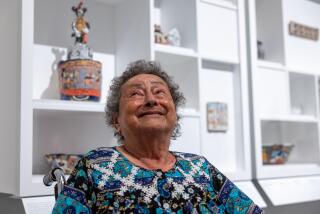Review: LACMA’s ‘Ming Masterpieces’ a mark of distinction
A new exhibition of Chinese Ming dynasty paintings includes just 10 works, one each by 10 artists, but it’s more absorbing than many shows two or three times its size. These 15th and early-16th century paintings are high-wire acts of aesthetic dexterity, fusing philosophical perception with formal persuasion.
At the Los Angeles County Museum of Art, “Ming Masterpieces from the Shanghai Museum” is focused on court painters associated with the imperial painting academy in Beijing’s Forbidden City. As with all academies, training there focused on harnessing manual skill to officially sanctioned doctrine. Five of the show’s 10 painters were court artists, and five were professionals whose styles are directly related to those in the court.
Zhou Wenjing’s intricate “New Year’s Day” is a richly detailed scene in which dozens of guests arriving at a grand country house beneath mist-shrouded mountains personify peaceful fraternity. Orderliness, civilized etiquette and dignified structure permeates their courtly arrival. The new year — a symbolic fresh start — is rendered as a scene of political harmony and grace.
FULL COVERAGE: 2013 Spring arts preview
Stylistically, Zhou’s 4-foot-tall hanging scroll, which is drawn in ink on silk, is entirely different from something like Ambrogio Lorenzetti’s famous “Allegory of Good Government,” a monumental landscape fresco painted for the town hall in Siena, Italy, about a hundred years earlier. The Chinese painting adapts an almost calligraphic brushwork largely limited to blacks and grays, while the Italian melds direct observation with pictorial compositions familiar in colorful manuscripts. But the intent of these two officially sanctioned artists is essentially the same.
Look on me and rest assured, their pictures seem to say. Under existing command, all is well. Seeing equals knowledge.
One of the most beautiful works is Lin Liang’s monochrome “Birds and Bamboo,” a hanging scroll showing pheasants and doves in a rocky landscape. Just over 5 feet tall, its depicted elements are roughly life-size. Reading from bottom to top, the birds are deployed in a sinuous S-curve that is carried along by graceful landscape forms.
And how magically they are painted! Lin alternates a thinned ink-wash with unpainted silk, so that positive and negative shapes of feathers, rock, vegetation, shadows and air form an evanescent composition. Nature seems to coalesce and evaporate in patterned rhythms.
A pheasant hunched at bottom looks up toward a second bird, whose long, graceful tail feathers rise up toward a dove hovering in space. The feathers’ shapes, unpainted but defined by contour drawing, are matched by tall stalks of bamboo painted in dark ink. The feathers and stalks open to the left like a fan, pulling the eye from the hovering dove to a companion bird suddenly discovered nestled within the bamboo. Lin creates a masterful illusion of levitation into flickering sky from the gravity-bound earth.
The illusion is helped along by the painting’s materials. Ink wash on silk is soft rather than crisp in both its surface and contours. Ranging from light to dark, the tonal layers possess a special capacity to convey variable atmosphere.
PHOTOS: Arts and culture in pictures
Silk also has an inherent sheen. The scroll is unfortunately (if necessarily) displayed inside a wall-mounted plexiglass case, which at least has the virtue of allowing close scrutiny. Even boxed it’s still possible to see how, as a primary compositional tool, the artist skillfully exploited the absorption and reflection of ambient light across silk. The gentle, low-key shimmer assists in creating the ephemeral aspects of the avian image.
Other scrolls show a man miraculously bathed in moonlight while playing the zither (Wu Wei); figures in a grove of crisp autumn leaves and trees shedding foliage (Du Jin); a Dao immortal swept away on the back of an enormous carp (Li Zai); and a scholar adrift in a boat that seems poised to float away into nature’s infinite expanse (Wu Shien, gifted son of Wu Wei).
In a marvelous Wang Zhao scroll that is both touching and witty, a traveler on life’s path (the Dao immortal, Li Tieguai) has stopped to lace his sandal next to a rushing waterfall. Wang shows Li taking care on a journey embedded in a context of perpetual change.
The show also includes one hand-scroll, plus an album of individual leaves. (For conservation reasons, the six gold-flecked paper sheets from the album will be changed on April 24.) Jiang Song’s exquisite scroll depicts a scholar walking through the countryside on his way to visit a friend in a rustic house. But the clever design puts you in the position of the waiting host, not the visitor, anticipating an arrival. Scan across the field and, like a delightful surprise, the trudging scholar and his attendant suddenly appear in the distance.
Among the sheets in Zhang Lu’s album, the sense of improvisation in an extraordinary drawing of a shrouded moon hovering above a swelling ocean is more dramatic than anything in the show. Animated brushwork creates nature’s churning mysteries — and is simultaneously swallowed within them.
According to LACMA curator Stephen Little, who organized the modest but potent assembly, these Ming paintings deviate from the norm found in American museums. More familiar are paintings from the literati tradition in southern China, where amateur artists who had retired from bureaucratic duties were unhinged from courtly standards and demands.
That might reflect a modern Western bias for individualism and against academic art. Either way, exhibitions like this one, rarely seen in the United States, add a welcome dimension.
-----------------------------------
‘Ming Masterpieces’
Where: LACMA, 5905 Wilshire Blvd.
When: Through June 2. Closed Wednesdays.
Information: (323) 857-6000 or https://www.lacma.org
christopher.knight@latimes.com
MORE
INTERACTIVE: Christopher Hawthorne’s On the Boulevards
Depictions of violence in theater and more
PHOTOS: Arts and culture in pictures
More to Read
The biggest entertainment stories
Get our big stories about Hollywood, film, television, music, arts, culture and more right in your inbox as soon as they publish.
You may occasionally receive promotional content from the Los Angeles Times.











